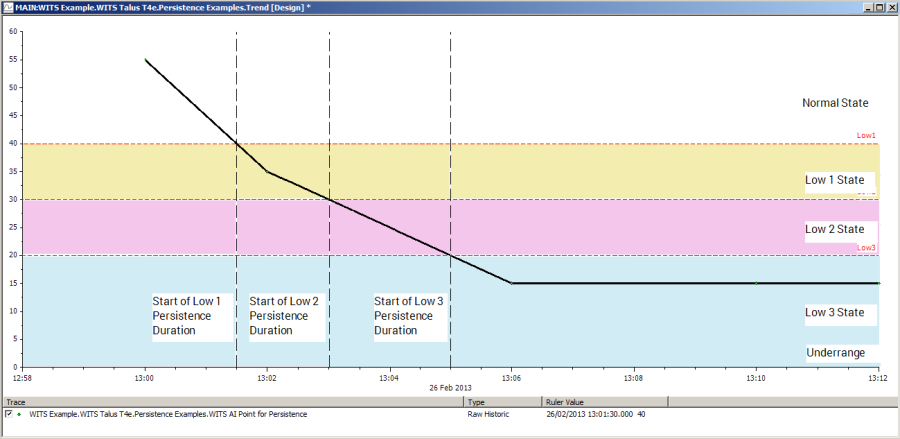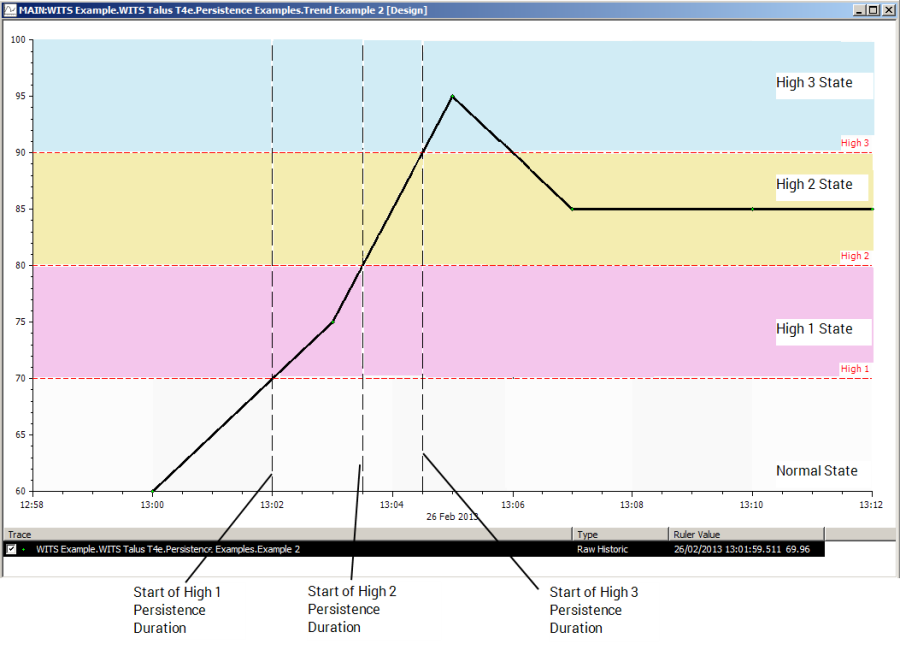If your WITS Field Device supports separate Persistence per point limit, it is possible to configure non-sequential persistence for analog points. This is when limits have Persistence durations that may not expire in limit order.
With non-sequential Persistence, the Persistence Duration starts as soon as the point value crosses a limit. If the point value crosses multiple limits, the Persistence Durations for each of those limits are started, and run at the same time. As a result of this, the Persistence Durations may expire in a non-sequential order.
Example:
High 4, Persistence: 30S
High 3, Persistence: 15S
High 2, Persistence: 20S
High 1, Persistence: 10S
With this configuration in place, the High 3 limit is non-sequential, as it is shorter than the High 2 limit. This means that High 3 may expire before High 2.
The following examples show how non-sequential persistence is applied in two different scenarios.
Example 1: Point Value Crosses Multiple Limits in Descending Order, Persists in Lower Limit
An analog point is configured to have:
Low 1: Limit: 40; Persistence: 8M
Low 2: Limit: 30; Persistence: 6M
Low 3: Limit: 20; Persistence: 3M
At 13:00:00, the analog point's value is 55, which means it is in the Normal state.
At 13:01:30, the analog point's value drops to 40 and so crosses the Low 1 threshold. The Persistence duration for Low 1 begins and will expire in 8 minutes' time at 13:09:30.
At 13:03:00, the analog point's value drops to 30, and so crosses the Low 2 threshold. The Persistence duration for Low 2 begins and will expire in 6 minutes' time at 13:09:00.
At 13:05:00, the analog point's value drops to 20, and so crosses the Low 3 threshold. The Persistence duration for Low 3 begins and will expire in 3 minutes' time at 13:08:00.
The analog point's value continues to fall until 13:06:00, where, at a value of 15, it remains stable.

At 13:08:00, the analog point's value Low 3 Persistence duration expires. The point value is 15 and so has remained in the Low 3 range for the entirety of the Low 3 Persistence duration. As a result, the point changes state to Low 3.
At 13:09:00, the Persistence duration for Low 2 expires. The point value is still 15, and so there is no change to the point's state - it remains in Low 3 (as Low 3 is lower than Low 2).
At 13:09:30, the Persistence duration for Low 1 expires. As the point value is still 15, there is no change to the point's state - it remains in Low 3 (as Low 3 is lower than Low 1).
Example 2: Point Value Crosses Multiple High Limits, Does Not Persist in Higher Limit
An analog point is configured to have:
High 3: Limit: 90; Persistence: 2M
High 2: Limit: 80; Persistence: 6M
High 1: Limit: 70; Persistence: 8M
At 13:00:00 the analog point has a value of 50.0 and is in the Normal state.
At 13:02:00, the analog point's value rises to 70. This means the value has risen out of the Normal range and into the High 1 range. The Persistence duration begins and will expire at 13:10:00. At this stage, the point remains in its previous state (Normal).
The point value continues to rise and at 13:03:30, it rises to 80. The value has crossed the High 1 range and entered the High 2 range, and so the High 2 Persistence duration begins. It will end in 6 minutes' time, at 13:09:30. The point is still in the Normal state as neither of the High 1 or High 2 Persistence durations have expired.
At 13:04:30, the point's value rises to 90, and so enters the High 3 range. The High 3 Persistence duration begins and will end in 2 minutes' time, at 13:06:30.
At 13:06:00, the point value drops below 90 and so enters the High 2 range.The High 3 Persistence duration is canceled as the point's value did not remain in the High 3 range for the High 3 Persistence duration.
The point's value continues to drop, until 13:07:00 when it reaches 85, at which point it remains stable at 85.
At 13:09:30, the High 2 Persistence duration expires. The point changes state to High 2 as its value has been in the High 2 range or above for the entire Persistence duration of High 2.
At 13:10:00, the High 1 Persistence duration expires. The point does not change state, as its value remains in the High 2 range (High 2 is higher than High 1).
